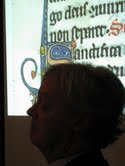 At the beginning of the day we were asked to pick one of the three dozen or so manuscript fragments on the table and do our best to describe them (date, region, script, etc.). I didn’t do too badly, given that I happened to pick the only work in Dutch (I posited 15th century, German or Dutch, from a Book of Hours, possibly part of the penitential psalms), and was happy to see that I was correct in the main (it is catalogued as from a Dutch Book of Hours, 1475, Use of Utrecht, though that is not certain). We discussed using ultraviolet light to detect erased text—and, paraphrasing de Hamel, it is only useful 25% of the time, but of those times one often makes SPECTACULAR discoveries.
At the beginning of the day we were asked to pick one of the three dozen or so manuscript fragments on the table and do our best to describe them (date, region, script, etc.). I didn’t do too badly, given that I happened to pick the only work in Dutch (I posited 15th century, German or Dutch, from a Book of Hours, possibly part of the penitential psalms), and was happy to see that I was correct in the main (it is catalogued as from a Dutch Book of Hours, 1475, Use of Utrecht, though that is not certain). We discussed using ultraviolet light to detect erased text—and, paraphrasing de Hamel, it is only useful 25% of the time, but of those times one often makes SPECTACULAR discoveries.
 There followed a more formal introduction by de Hamel to medieval catalogues (essentially inventories of libraries), and the standard practice (developed at the Sorbonne in the late 13th century) of citing a manuscript by using the first words (incipit) of its second leaf AND its penultimate leaf. Late medieval catalogues also include printed books (which often constitute as much as 50% of the inventory), despite an often-made assumption that all of them are in manuscript. The late morning session was a powerpoint presention on the provenancing of a leaf from a manuscript containing the writings Thomas Aquinas—in the course of which we discussed the “pecia” system of production that was employed from the 13th century onward, whereby an approved exemplar manuscript was divided into sections and hired out to stationers to copy, both to increase production and to limit error rates. At 6:00pm deHamel lectured at the Columbia Museum of Art to about 60 people, on the medieval Book of Hours as art, and his brilliant presentation received the warm approbation it deserved.
There followed a more formal introduction by de Hamel to medieval catalogues (essentially inventories of libraries), and the standard practice (developed at the Sorbonne in the late 13th century) of citing a manuscript by using the first words (incipit) of its second leaf AND its penultimate leaf. Late medieval catalogues also include printed books (which often constitute as much as 50% of the inventory), despite an often-made assumption that all of them are in manuscript. The late morning session was a powerpoint presention on the provenancing of a leaf from a manuscript containing the writings Thomas Aquinas—in the course of which we discussed the “pecia” system of production that was employed from the 13th century onward, whereby an approved exemplar manuscript was divided into sections and hired out to stationers to copy, both to increase production and to limit error rates. At 6:00pm deHamel lectured at the Columbia Museum of Art to about 60 people, on the medieval Book of Hours as art, and his brilliant presentation received the warm approbation it deserved.
Tags: conferences